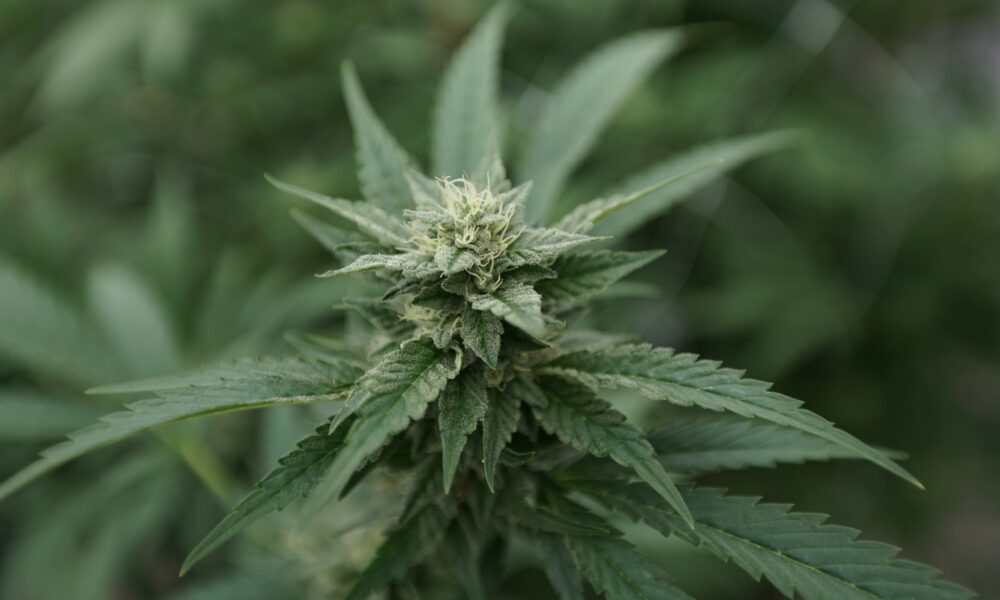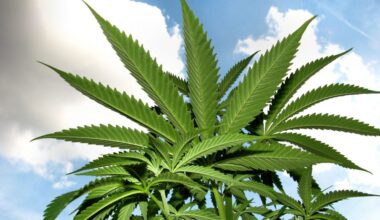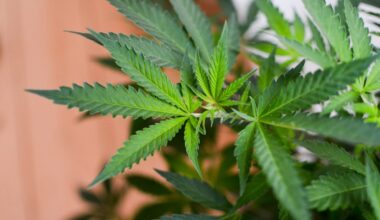House Appropriations Committee leaders have released yet another set of spending bill reports that touch on marijuana and other drug policy issues like kratom, with this latest batch focusing on cannabis research barriers, impaired driving and preventing use by youth and pregnant people.
Additionally, at a committee markup on Tuesday, members separately approved an amendment aimed at removing a federal funding cap to reimburse local and state police departments that are partners in a cannabis eradication program targeting illicit growers.
The newly released reports, meanwhile, cover funding for the Departments of Labor, Health and Human Services (HHS), Education, Transportation and Interior for the 2023 Fiscal Year.
Much of the report language centers on studying cannabis, including one section that reiterates the committee’s ongoing concerns about barriers associated with investigating Schedule I drugs like marijuana that “effectively limit the amount and type of research that can be conducted.”
While the report says it appreciates that the National Institute on Drug Abuse (NIDA) has submitted documentation outlining the research implications of the strict scheduling of certain substances, it notes there are still challenges such as the fact that scientists are still not able to access cannabis from dispensaries, even though President Joe Biden signed an infrastructure bill last year that included provisions meant to promote such access.
“Barriers to Research.—The Committee is concerned that restrictions associated with Schedule I of the Controlled Substance Act effectively limit the amount and type of research that can be conducted on certain Schedule I drugs, especially opioids, marijuana or its component chemicals, and new synthetic drugs and analogs. At a time when as much information as possible about these drugs is needed, including research on their therapeutic potential and on overdose reversal agents, it would be helpful to lower regulatory and other barriers to conducting this research. The Committee appreciates NIDA’s completion of a report on the barriers to research that result from the classification of drugs and compounds as Schedule I substances, including the challenges researchers face as a result of limited access to sources of marijuana including dispensary products.”
Further, the report talks about the need to develop “an objective standard to measure marijuana impairment to ensure highway safety.” It again emphasizes that part of the solution means freeing up researchers to obtain cannabis products from state-legal retailers that reflect “the diversity, quality, and potency of products commonly available to patients or consumers.”
“Marijuana Research.—The Committee supports the development of an objective standard to measure marijuana impairment to ensure highway safety. Essential to that development are high-quality scientific studies using marijuana and products containing marijuana lawfully available to patients or consumers in a State on a retail basis. The Committee notes that a majority of Federal research on marijuana has been limited to a single strain of marijuana that is not fully representative. The Committee emphasizes the need for research that encompasses the diversity, quality, and potency of products commonly available to patients or consumers in a State on a retail basis. The Committee requests an update on efforts to expand researcher access to different marijuana strains in the fiscal year 2024 Congressional Justification.”
—
Marijuana Moment is tracking more than 1,500 cannabis, psychedelics and drug policy bills in state legislatures and Congress this year. Patreon supporters pledging at least $25/month get access to our interactive maps, charts and hearing calendar so they don’t miss any developments.![]()
Learn more about our marijuana bill tracker and become a supporter on Patreon to get access.
—
The committee further argued that funding for marijuana research has not kept pace with the spread of the state-level legalization movement, and it encouraged the National Institutes on Health (NIH) to support increased studies into potential therapeutic applications of cannabis and its constituents.
“Cannabis Research.—The Committee recognizes that although concrete steps have been taken towards ameliorating the regulatory and supply issues hampering cannabis research in the U.S., funding levels have not kept pace with widespread use of cannabis and substantial clinical interest in the field. Cannabis is fully legal in 18 States and the District of Columbia, effectively so in 20 others that permit some form of medical marijuana, and consumed by nearly half of American teens and adults at some time in their lives, yet there is surprisingly little information about its effects on body chemistry and cognition. The Committee is concerned that marijuana policies on the Federal level and in the States (medical marijuana, recreational use, etc.) are being changed without the benefit of scientific research to help guide those decisions. While there are FDA-approved prescription medications that contain cannabidiol or THC which are used to treat various conditions such as certain seizure disorders and nausea associated with chemotherapy, research is needed to determine if cannabis or cannabis products could effectively treat chronic pain, certain mental illnesses, opioid use disorder or other substance use disorders, among other conditions. Therefore, the Committee encourages NIH to fund cannabis research to study efficacy of cannabinoid therapies for patients. NIH is encouraged to continue supporting a full range of research on the health effects of marijuana and its components, including research to understand how marijuana policies affect public health.”
In the interest of ensuring that marijuana research is effectively sustained, the committee also included a section on the importance of safeguarding universities that carry out studies into Schedule I drugs like cannabis from facing penalties such as the loss of federal funding. It references a provision that’s including in the spending bill for the Department of Education.
“Protecting Scientific Research on Marihuana.—Through scientific research, institutions of higher education advance our understanding and knowledge of various aspects of our world. Moreover, when in the public interest, such institutions should be able to conduct such research without fear of reprisal or loss of Federal funding. This includes research on cannabis, a Schedule I controlled substance under the Controlled Substances Act. As more States and localities move to legalize cannabis, many institutions of higher education are expanding the knowledge-base on this controlled substance. As a result, the Committee notes that such research is in the public interest, and the recommendation includes new bill language prohibiting the Department from penalizing institutions of higher education that conduct scientific research on marihuana.”
The committee also notes that $2 million are being appropriated to NIDA for interagency work to determine “the scope of the problem of underage youth and perinatal marijuana use and effective ways of reducing it.”
“Youth and Perinatal Marijuana Use.—The Committee includes $2,000,000 for NIDA to enter into a contract with NASEM to commission a study to determine the scope of the problem of underage youth and perinatal marijuana use and effective ways of reducing it. Topics explored should include but not be limited to the demographics of underage and perinatal marijuana use; its economic and social costs; adolescent and perinatal decision making and risk and protective factors; and the effectiveness of various prevention programs and approaches, including media campaigns, school-based education, pricing, and access. NASEM will develop a strategy for reducing and preventing underage and perinatal consumption of today’s marijuana and THC products, specifically focused on the impacts of THC on the developing brain. To help develop an effective strategy, NASEM shall review existing Federal, State, and non-governmental programs, including media-based programs, that have been shown to be effective with other substances that can be harmful to youth, including any done on marijuana, that are designed to change the attitudes and health behaviors of youth (those under the age of 21). In addition, NASEM shall review existing Federal, State, and non-governmental programs including media-based programs, that have been shown to be effective with other substances that can be harmful to babies of pregnant and breastfeeding women, including with any completed on marijuana, that are designed to change the attitudes and health behaviors of pregnant and breast-feeding women. Based on its reviews, NASEM shall produce a strategy designed to prevent and reduce underage consumption of today’s marijuana and THC products in addition to a strategy designed to prevent and reduce consumption of today’s marijuana and THC products by pregnant and breast-feeding women. This shall include, but not be limited to: an outline and implementation strategy; message points that will be effective in changing the attitudes and health behaviors of youth concerning underage marijuana consumption; and an outline and implementation strategy, and message points that will be effective in changing the attitudes and health behaviors of pregnant and breast-feeding women, target audience identification, goals and objectives of both campaigns, and the estimated costs of development and implementation.”
Notably, the report again talks about promoting research into kratom, a plant that has been used as an opioid alternative, as well as a therapeutic tool in combating withdrawal symptoms. Given the “potential promising results” of kratom, the committee is recommending human clinical trials to further explore the plant as a treatment option.
“Kratom.—The Committee recognizes that NIH- and NIDA-funded research has contributed to the continued understanding of the health impacts of kratom, including its constituent compounds, mitragynine and 7-hydroxymitragynine. The Committee is aware of the potential promising results of kratom for acute and chronic pain patients who seek safer alternatives to sometimes dangerously addictive and potentially deadly prescription opioids and of research investigating the use of kratom’s constituent compounds for opioid use disorder. The Committee acknowledges NIDA’s support of preclinical research on the toxicology of mitragynine, which will enable future studies of its safety, tolerability, and clinical pharmacokinetics in humans. The Committee also urges NIDA to consider a human clinical trial on its therapeutic effects to treat opioid use disorder, especially in light of the increases in overdose deaths reported during the COVID–19 pandemic.”
The report separately commends NIDA for supporting research on kratom as an opioid alternative.
“Combating Opioid Overdoses.—The Committee commends NIDA for funding studies on kratom based on promising results that unadulterated kratom may provide help for some Americans struggling with addictions, given its analgesic and less addictive properties as compared to opioids.”
For the Transportation Department report, the committee said it “remains concerned with the growing problem of people driving under the influence of one or multiple substances, including marijuana and opioids.”
To that end, it wants the National Highway Traffic Safety Administration (NHTSA) to continue its work in training police to detect impaired driving from THC, develop improved field sobriety tests for marijuana and “work with states to determine their toxicology testing and funding needs.” It goes on to reiterate that access to a diverse range of marijuana products available to consumers in state markets could bolster research into the issue.
“Drug-impaired driving.—The Committee remains concerned with the growing problem of people driving under the influence of one or multiple substances, including marijuana and opioids. The Committee encourages NHTSA to continue funding training efforts to ensure stakeholders can identify drug-impaired driving and enforce the law. Funding under this heading is provided to continue research with the goal of developing a standardized field sobriety test to detect marijuana impairment. The Committee continues to direct NHTSA to work with the Department of Justice, the Department of Health and Human Service, and the Department of Commerce to ensure that state highway safety offices and state law enforcement have the most up-to-date information from the Federal government on detecting impaired driving. In order to increase the safety of the transportation network by reducing drug-impaired driving, the Committee directs NHTSA to work with states to determine their toxicology testing and funding needs and to make states aware that assistance for state toxicology labs are eligible expenses under section 402 and 405 formula grant funds.
Further, the Committee notes that section 25026 of the IIJA, requires the Secretary, in consultation with the Attorney General and Secretary of Health and Human Services, to complete a report with recommendations for increasing and improving access to samples and strains of marijuana for scientific researchers studying impairment while driving under the influence of marijuana and establishing a national clearinghouse to collect and distribute samples and strains of marijuana for scientific research. The Committee emphasizes the need for research that encompasses the diversity, quality, and potency of marijuana products that are lawfully available to patients or consumers in a state on a retail basis. The Department is directed to brief the House and Senate Committees on Appropriations no later than 60 days after enactment of this Act on its progress in implementing section 25026 of the IIJA.”
The Interior report talks about efforts to combat illicit marijuana grow operations on public lands in California that pose environmental and public safety risks. The committee voiced support for partnerships between federal agencies and state, local and tribal governments related to “survey, reclamation, and prevention efforts to the maximum extent possible” to mitigate such issues. Also, the report expresses support for the Interior Department’s use of drones to identify illicit marijuana farms.
“MARIJUANA ON PUBLIC LANDS.-The Committee is aware that trespassers illegally grow marijuana on public lands in California. These unlawful activities harmfully impact the public, water, soil, and wildlife. The Committee supports Forest Service efforts to develop tools to detect and eradicate grow sites. The Committee directs the Forest Service and the Bureau of Land Management to continue to cooperate with state, local, and tribal governments on survey, reclamation, and prevention efforts to the maximum extent possible. The Committee also supports the Department of the Interior’s use of drones to conduct statewide remote-sensing surveys of federal public lands to identify grow sites and allow for the development of cost estimates for reclamation.”
And for the third time this appropriations season, the committee again recommends research into environmentally friendly and cost-effective alternatives to plastic, including hemp.
“The Committee notes the potential need for dependable bio-based and United States-grown plastic alternatives. Within 180 days of enactment of this Act, the Committee directs the Agency to provide a briefing on efforts to explore alternatives, such as United States-based hemp, and how such alternatives may be used as a cost-efficient alternative in government-produced or funded materials.”
Among all of the spending bills and attached reports that advocates have been monitoring, one of the most important covers appropriations for Commerce, Justice, Science, and Related Agencies (CJS), which was marked up by the full committee on Tuesday.
Activists and lawmakers cheered the panel’s voice vote approval of an amendment from Reps. Barbara Lee (D-CA) and Dave Joyce (R-OH) that would provide broad protections for states, U.S. territories and tribes that have legalized marijuana. Separately language preventing the Justice Department from using its funds to interfere in the implementation of medical cannabis programs was included in the base bill. That provision has been annually renewed since 2014.
Lee, as well as key champions of reform like Reps. Earl Blumenauer (D-OR), Eleanor Holmes Norton (D-DC), Tom McClintock (R-CA) and 44 other House lawmakers had previously sent a letter to Appropriations Committee leaders asking for the broader cannabis language in the base bill to avoid the amendment process.
In 2019 and 2020, the House attached the sweeping state and tribal protections to its version of the appropriations legislation as amendments adopted on the floor, but they’ve yet to be incorporated into any final package enacted into law. CJS legislation didn’t end up making it to the floor in 2021, but supporters had planned an amendment that year as well.
The committee on Tuesday also approved by voice vote an amendment from Rep. Mike Garcia (R-CA), which would remove a federal funding cap for local and state law enforcement agencies who partner with DOJ in a cannabis eradication program targeting illicit growers. Garcia described the $19,000 cap for reimbursements for such agencies as “arbitrary and capricious,” inhibiting the ability of state and local agencies to combat cartels that are growing marijuana out of compliance with state laws.
“SEC. __. None of the funds made available by this Act may be used to implement a limit on reimbursement available a to local law enforcement jurisdiction under the Domestic Cannabis Suppression/Eradication Program for the purpose of paying overtime pay to a law enforcement officer who engages in eradication efforts against unlicensed or unregistered cannabis grown in a State wherein production or sales of cannabis is lawful.”
“I just wanted to point out Californians voted to legalize marijuana in 2016, and we also promised to end the black market to stop this cartel violence,” Garcia said in his closing remarks on the measure. “But in typical for our state of California, we overtaxed over regulated the marijuana industry so it’s still cheaper to buy it on the black market.”
“Now the cartels are coming across the southern border, they set up these illegal marijuana grows. They’ve got 50-caliber machine guns, literally, protecting their grows and they’re terrorizing communities, steal water from various sources in order to water these grows, and law enforcement is stretched too thin as it is,” he said. “And so this [funding] is extremely important to make sure that we crack down on these illegal grow operations.”
Separately, House Appropriations Committee leaders are calling for a federal review of psilocybin policy, utilizing hemp as an alternative to Chinese plastics and letting researchers study marijuana from dispensaries in recent spending bill reports. Marijuana research and hemp as a plastics alternative have been hallmarks of several reports at this point.
There are other notable cannabis provisions that have been included in recently released spending bills and attached reports, including one submitted last week that encourages sports regulators to push international officials to “change how cannabis is treated” when it comes to suspending athletes from competition over positive tests.
Another report also more broadly addresses drug testing requirement for federal workers, as previous versions have done in the past. But this time, there’s a new line that specifically urges the executive branch to apply drug testing standards with “consistency and fairness.”
Meanwhile, in an education spending bill, there’s again a section that would prevent the Department of Education from penalizing universities simply because the institutions are conducting research into marijuana.
The House Appropriations Committee also released other spending bills and reports, with lawmakers pushing multiagency coordination to create guidance on hemp manufacturing, better guidance on the marketing of CBD, updates on research into medical marijuana for veterans and investigations into “alternative treatments” for post-traumatic stress disorder (PTSD) such as psychedelics.
Those provisions came out of Fiscal Year 2023 spending legislation for Agriculture, Rural Development, Food and Drug Administration (FDA), and Related Agencies, as well as Military Construction, Veterans Affairs (VA), and Related Agencies.
Another set of spending bills and reports that were recently released call for protections for immigrants who use cannabis, freeing up marijuana-related advertising and providing the industry with access to the banking system.
Importantly, it remains to be seen whether the Senate will accept any of the House-led cannabis and drug policy proposals. Senate appropriators have not yet released their spending bills for FY23, and typically wait until after the House has acted, so it’s not yet clear which issues will ultimately get reconciled by the two chambers and adopted into law.
Photo courtesy of Chris Wallis // Side Pocket Images.
Medical Disclaimer:
The information provided in these blog posts is intended for general informational and educational purposes only. It is not a substitute for professional medical advice, diagnosis, or treatment. Always seek the advice of your physician or other qualified healthcare provider with any questions you may have regarding a medical condition. The use of any information provided in these blog posts is solely at your own risk. The authors and the website do not recommend or endorse any specific products, treatments, or procedures mentioned. Reliance on any information in these blog posts is solely at your own discretion.







